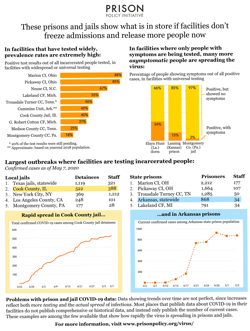Our new fact sheet illustrates what’s in store if prisons and jails don’t decarcerate now
Our fact sheet for advocates shows how rapidly the coronavirus can spread through correctional facilities, and how high infection rates in prisons and jails already are.
by Wendy Sawyer, May 8, 2020
To help advocates argue for more aggressive decarceration as COVID-19 spreads rapidly through the nation’s prisons and jails, we’ve created a one page PDF fact sheet.
The fact sheet includes new analysis of recent COVID-19 data, largely gathered by the UCLA School of Law COVID-19 Behind Bars Data Project, put into context using other government data sources. As a result, we were able to make a series of tables and charts to show:
- Prevalence rates of the virus in facilities that have conducted widespread testing;
- How many asymptomatic people test positive in facilities with universal testing — indicating that in places where only the few people with symptoms are being tested, many more untested people are spreading the virus;
- The largest outbreaks in jails and prisons where facilities are testing incarcerated people; and
- The rapid spread of the virus over time in the few places that publish historical data, such as the Cook County (Chicago) jail and Arkansas prison system.
We also discuss the problems with prison and jail COVID-19 data; namely, that the data we have only reflect test results, and most places still are not testing widely. What we’ve learned from the places testing everyone — not just people showing symptoms — is that the virus is rampant among incarcerated people and correctional staff, which means that some prisons and jails are acting as “spreaders” of the virus in local communities.
The rapid spread of the virus among incarcerated people is unsurprising, since social distancing is impossible in the close quarters of prisons and jails. And incarcerated people, who disproportionately suffer from chronic illnesses that make them more vulnerable to the virus, are at incredible risk. As our new fact sheet shows, federal, state, and local authorities must freeze admissions and release more people now to prevent further spread of the virus through incarceration.




